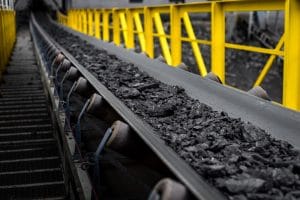Using Remote Conveyor Monitoring to Eliminate Unplanned Downtime

How do you find a tear in a conveyor belt cover that might be several miles long? How do you detect problems with idler roller bearings before they seize? How do you discover a belt is tracking badly before it gets damaged and product is lost?
Unless you’ve implemented remote conveyor monitoring technology, finding the answer to these questions is hard. Human observation and reporting can’t be relied on because very often the belt is inaccessible. Scheduled inspections and maintenance are great in theory but in practice, they give way to the pressure for output. And when there is time for preventive maintenance can you be sure you’re working on the things that need it most?
BREAKDOWNS HURT FINANCIAL PERFORMANCE
An unplanned conveyor belt stoppage is disruptive and expensive. In many mines, there’s no alternative to using a conveyor to move rock away from the face, so without a functioning belt, output stops.
Repairs are rarely easy or quick. Given the length of the system and the difficulty of reaching every part, it can take hours, if not days, to locate and diagnose the problem. Actually making the repairs needed takes yet more time, even if the spares are in stock. And all the while, people and machines are idle and schedules are being missed.
REMOTE CONVEYOR MONITORING IN MINING HAS A MEASURABLE PAYBACK
Imagine being able to anticipate failures before they happen. Here’s what that would mean:
- Replacement parts would be ordered in advance – no premium freight charges and no waiting for delivery.
- Maintenance work could be planned for when it has the least impact on output – no unexpectedly idle equipment or people.
- With no unexpected stoppages production would stay on target and schedules would be met.
Best of all, there’s no pressure to run harder to catch up lost output as is so often the case, because no breakdowns mean no falling behind. That would create the time to do the inspections and maintenance that are needed but never get done.
REMOTE MONITORING TECHNOLOGY FOR CONVEYOR BELTS
No single product or tool will provide all the information you need about your conveyor systems. The answer takes the form of a suite of technologies. That means you can pick and choose those that are most appropriate to your systems and operations.
The remote monitoring technologies available today include:
- Camera systems for detecting tears in covers
- Idler roller vibration monitoring
- Belt tracking/misalignment detection
- Bearing temperature monitoring
- Gearbox/reducer vibration monitoring
- Motor current draw (for tracking energy consumption and belt load)
- Oil temperatures and pressures
- Temperatures inside control cabinets
- Fan currents, to detect dirty filters, (or use pressure drop measurements)
In addition, a remote conveyor monitoring system needs communications technology to get the data to where it can be viewed, analyzed, and put to use. Wireless works in some situations, Ethernet-based systems are another option, and then there’s fiber-optic transmission for higher speeds, bandwidth, and durability.
Choosing the right monitoring equipment can be a challenge. That’s why it pays to partner with conveyor specialists who understand what you need and what’s available. Since the 1980s West River Conveyors has built systems for the most challenging environments, above and below ground.
TURNING DATA INTO ACTIONABLE INTELLIGENCE
Monitoring technology provides numbers. That may be enough to identify when things are moving outside normal operating parameters, but likely not. It certainly won’t reveal how quickly something is deteriorating, which is key to scheduling repair or replacement before failure. Doing that needs history and the tools to analyze that data.
Take a tear in a conveyor belt cover as an example. Planning replacement means knowing when the tear first appeared and how quickly it’s growing. It would help to know how quickly the last tear developed, and you’ll also want to know where on the belt it is located.
A conveyor monitoring system can provide this information. It logs past events, builds a history, and allows comparisons. The same applies to other monitoring tools. If the motor current draw is rising, how long will it be before a serious problem occurs? Will an abnormally hot bearing seize today or next week? Information on what has happened before is invaluable in understanding equipment conditions and planning maintenance work.
Data capture and analysis is a complex topic. West River Conveyors follow industry and technology trends and can advise on what’s possible, what’s practical, and what can be done.
REMOTE CONVEYOR MONITORING WILL BENEFIT THE BOTTOM LINE
Life is good when everything stays on schedule. Or if not good, at least not uncomfortable. An unplanned stoppage changes that, wreaking havoc on plans, costs, and budgets.
Using remote conveyor monitoring in mining is like seeing into the future. You’ll have advanced knowledge of impending problems so you’ll be able to plan accordingly. Order replacement parts without paying premium shipping charges, schedule manpower for when it’s least expensive and coordinate with operations to find the least impactful time to do the work.
This isn’t a fantasy or pipe dream. The technology exists and is available for your system.

